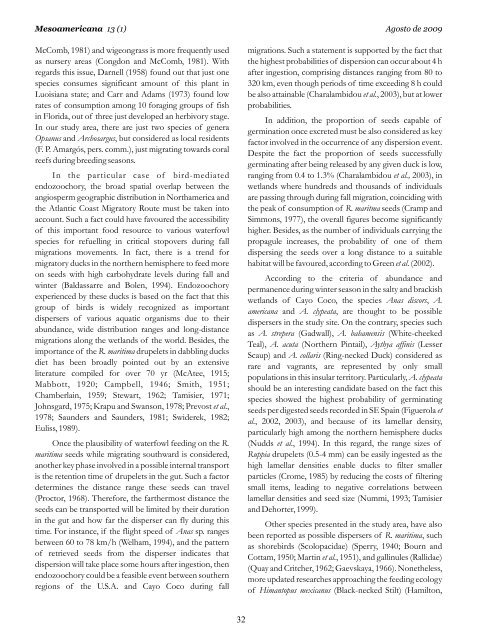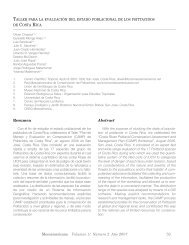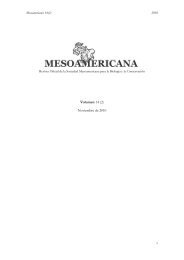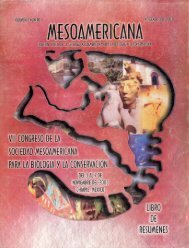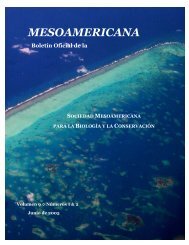MESOAMERICANA - Sociedad Mesoamericana para la BiologÃa y la ...
MESOAMERICANA - Sociedad Mesoamericana para la BiologÃa y la ...
MESOAMERICANA - Sociedad Mesoamericana para la BiologÃa y la ...
Create successful ePaper yourself
Turn your PDF publications into a flip-book with our unique Google optimized e-Paper software.
<strong>Mesoamericana</strong> 13 (1) Agosto de 2009<br />
McComb, 1981) and wigeongrass is more frequently used<br />
as nursery areas (Congdon and McComb, 1981). With<br />
regards this issue, Darnell (1958) found out that just one<br />
species consumes significant amount of this p<strong>la</strong>nt in<br />
Luoisiana state; and Carr and Adams (1973) found low<br />
rates of consumption among 10 foraging groups of fish<br />
in Florida, out of three just developed an herbivory stage.<br />
In our study area, there are just two species of genera<br />
Opsanus and Archosargus, but considered as local residents<br />
(F. P. Amargós, pers. comm.), just migrating towards coral<br />
reefs during breeding seasons.<br />
In the particu<strong>la</strong>r case of bird-mediated<br />
endozoochory, the broad spatial over<strong>la</strong>p between the<br />
angiosperm geographic distribution in Northamerica and<br />
the At<strong>la</strong>ntic Coast Migratory Route must be taken into<br />
account. Such a fact could have favoured the accessibility<br />
of this important food resource to various waterfowl<br />
species for refuelling in critical stopovers during fall<br />
migrations movements. In fact, there is a trend for<br />
migratory ducks in the northern hemisphere to feed more<br />
on seeds with high carbohydrate levels during fall and<br />
winter (Baldassarre and Bolen, 1994). Endozoochory<br />
experienced by these ducks is based on the fact that this<br />
group of birds is widely recognized as important<br />
dispersers of various aquatic organisms due to their<br />
abundance, wide distribution ranges and long-distance<br />
migrations along the wet<strong>la</strong>nds of the world. Besides, the<br />
importance of the R. maritima drupelets in dabbling ducks<br />
diet has been broadly pointed out by an extensive<br />
literature compiled for over 70 yr (McAtee, 1915;<br />
Mabbott, 1920; Campbell, 1946; Smith, 1951;<br />
Chamber<strong>la</strong>in, 1959; Stewart, 1962; Tamisier, 1971;<br />
Johnsgard, 1975; Krapu and Swanson, 1978; Prevost et al.,<br />
1978; Saunders and Saunders, 1981; Swiderek, 1982;<br />
Euliss, 1989).<br />
Once the p<strong>la</strong>usibility of waterfowl feeding on the R.<br />
maritima seeds while migrating southward is considered,<br />
another key phase involved in a possible internal transport<br />
is the retention time of drupelets in the gut. Such a factor<br />
determines the distance range these seeds can travel<br />
(Proctor, 1968). Therefore, the farthermost distance the<br />
seeds can be transported will be limited by their duration<br />
in the gut and how far the disperser can fly during this<br />
time. For instance, if the flight speed of Anas sp. ranges<br />
between 60 to 78 km/h (Welham, 1994), and the pattern<br />
of retrieved seeds from the disperser indicates that<br />
dispersion will take p<strong>la</strong>ce some hours after ingestion, then<br />
endozoochory could be a feasible event between southern<br />
regions of the U.S.A. and Cayo Coco during fall<br />
32<br />
migrations. Such a statement is supported by the fact that<br />
the highest probabilities of dispersion can occur about 4 h<br />
after ingestion, comprising distances ranging from 80 to<br />
320 km, even though periods of time exceeding 8 h could<br />
be also attainable (Chara<strong>la</strong>mbidou et al., 2003), but at lower<br />
probabilities.<br />
In addition, the proportion of seeds capable of<br />
germination once excreted must be also considered as key<br />
factor involved in the occurrence of any dispersion event.<br />
Despite the fact the proportion of seeds successfully<br />
germinating after being released by any given duck is low,<br />
ranging from 0.4 to 1.3% (Chara<strong>la</strong>mbidou et al., 2003), in<br />
wet<strong>la</strong>nds where hundreds and thousands of individuals<br />
are passing through during fall migration, coinciding with<br />
the peak of consumption of R. maritma seeds (Cramp and<br />
Simmons, 1977), the overall figures become significantly<br />
higher. Besides, as the number of individuals carrying the<br />
propagule increases, the probability of one of them<br />
dispersing the seeds over a long distance to a suitable<br />
habitat will be favoured, according to Green et al. (2002).<br />
According to the criteria of abundance and<br />
permanence during winter season in the salty and brackish<br />
wet<strong>la</strong>nds of Cayo Coco, the species Anas discors, A.<br />
americana and A. clypeata, are thought to be possible<br />
dispersers in the study site. On the contrary, species such<br />
as A. strepera (Gadwall), A. bahamensis (White-cheeked<br />
Teal), A. acuta (Northern Pintail), Aythya affinis (Lesser<br />
Scaup) and A. col<strong>la</strong>ris (Ring-necked Duck) considered as<br />
rare and vagrants, are represented by only small<br />
popu<strong>la</strong>tions in this insu<strong>la</strong>r territory. Particu<strong>la</strong>rly, A. clypeata<br />
should be an interesting candidate based on the fact this<br />
species showed the highest probability of germinating<br />
seeds per digested seeds recorded in SE Spain (Figuero<strong>la</strong> et<br />
al., 2002, 2003), and because of its <strong>la</strong>mel<strong>la</strong>r density,<br />
particu<strong>la</strong>rly high among the northern hemisphere ducks<br />
(Nudds et al., 1994). In this regard, the range sizes of<br />
Ruppia drupelets (0.5-4 mm) can be easily ingested as the<br />
high <strong>la</strong>mel<strong>la</strong>r densities enable ducks to filter smaller<br />
particles (Crome, 1985) by reducing the costs of filtering<br />
small items, leading to negative corre<strong>la</strong>tions between<br />
<strong>la</strong>mel<strong>la</strong>r densities and seed size (Nummi, 1993; Tamisier<br />
and Dehorter, 1999).<br />
Other species presented in the study area, have also<br />
been reported as possible dispersers of R. maritima, such<br />
as shorebirds (Scolopacidae) (Sperry, 1940; Bourn and<br />
Cottam, 1950; Martin et al., 1951), and gallinules (Rallidae)<br />
(Quay and Critcher, 1962; Gaevskaya, 1966). Nonetheless,<br />
more updated researches approaching the feeding ecology<br />
of Himantopus mexicanus (B<strong>la</strong>ck-necked Stilt) (Hamilton,


